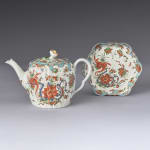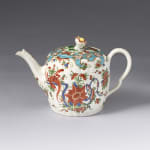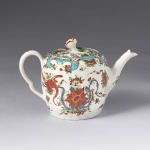


A Very Rare Worcester Teapot, Cover, and Stand, Circa 1770
Further images
A Very Rare Worcester Teapot, Cover, and Stand painting in the Japanese style as an interpretation of Kakiemon. The fluted stand with blue celeste border and gilt rim features a vibrant dragon pattern with Kakiemon floral sprays and insects similarly painted along the ribbed barrel shaped body of the teapot with ear-shaped handle and cover featuring a finial of an open bloom with yellow centre.
This pattern is colloquially referred to as the ‘Jabberwocky’ patten which is a Victorian invention originating from Lewis Carroll’s Through the Looking Glass, and What Alice Found There published in 1871. The pattern is a Worcester interpretation of Japanese Kakiemon style decoration which is mentioned in the 1769 Worcester Sales catalogue: ‘A complete tea and coffee equipage, forty three pieces, of the fine rich dragon pattern, blue Celeste borders’, sold for £6.17s.6d.
Provenance
See discussion in Simon Spero & John Sandon, Worcester Porcelain 1751-1790 The Zorensky Collection (1996), cat. 297 p. 249.
See a similarly decorated example without its stand in the Aberdeen Art Gallery (ABDMS082123)
Literature
See discussion in Simon Spero & John Sandon, Worcester Porcelain 1751-1790 The Zorensky Collection (1996), cat. 297 p. 249.
See a similarly decorated example without its stand in the Aberdeen Art Gallery (ABDMS082123)
Join our mailing list
* denotes required fields
We will process the personal data you have supplied in accordance with our privacy policy (available on request). You can unsubscribe or change your preferences at any time by clicking the link in our emails.


